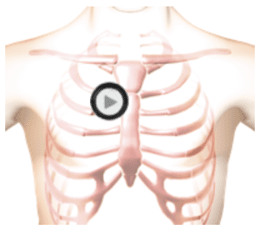Here is an example of moderate aortic stenosis combined with mild aortic regurgitation in a patient with rheumatic heart disease.
The first heart sound is normal.
The second heart sound is unsplit.
There is an aortic ejection click in systole followed by a diamond-shaped systolic murmur.
There is a high-pitched decrescendo murmur which fills the first two thirds of diastole.
In the anatomy video you can see a thickened left ventricle and thickened but mobile aortic valve leaflets. There is moderate turbulent flow across the aortic valve in systole and mild regurgitant turbulent flow into the left ventricle in diastole.
The turbulent blood flow causes the systolic and diastolic murmurs.
Aortic Stenosis Moderate and Regurgitation Mild - Rheumatic Origin 121 Audio


Aortic Stenosis Moderate and Regurgitation Mild - Rheumatic Origin 121 Sounds


Half Speed Aortic Stenosis Moderate and Regurgitation Mild - Rheumatic Origin 121 Sounds


Technique

The patient's position should be sitting leaning forward.
Auscultation Tips for Aortic Stenosis Moderate and Regurgitation Mild - Rheumatic Origin 121
Systole:Aortic ejection click followed by diamond shaped murmurDiastole:high-pitch decrescendo murmur
Sound Wave
Aortic Stenosis Moderate and Regurgitation Mild - Rheumatic Origin 121 Video
In the animation, observe a thickened left ventricle and thickened but mobile aortic valve leaflets. There is moderate turbulent flow across the aortic valve in systole and mild regurgitant turbulent flow into the left ventricle in diastole.
The turbulent blood flow causes the systolic and diastolic murmurs.
Authors and Sources
Authors and Reviewers
- ECG heart rhythm modules: Thomas O'Brien.
- ECG monitor simulation developer: Steve Collmann
-
12 Lead Course: Dr. Michael Mazzini, MD.
- Spanish language ECG: Breena R. Taira, MD, MPH
- Medical review: Dr. Jonathan Keroes, MD
- Medical review: Dr. Pedro Azevedo, MD, Cardiology
- Last Update: 11/8/2021
Sources
-
Electrocardiography for Healthcare Professionals, 6th Edition
Kathryn Booth and Thomas O'Brien
ISBN10: 1265013470, ISBN13: 9781265013479
McGraw Hill, 2023 -
Rapid Interpretation of EKG's, Sixth Edition
Dale Dublin
Cover Publishing Company -
EKG Reference Guide
EKG.Academy -
12 Lead EKG for Nurses: Simple Steps to Interpret Rhythms, Arrhythmias, Blocks, Hypertrophy, Infarcts, & Cardiac Drugs
Aaron Reed
Create Space Independent Publishing -
Heart Sounds and Murmurs: A Practical Guide with Audio CD-ROM 3rd Edition
Elsevier-Health Sciences Division
Barbara A. Erickson, PhD, RN, CCRN -
The Virtual Cardiac Patient: A Multimedia Guide to Heart Sounds, Murmurs, EKG
Jonathan Keroes, David Lieberman
Publisher: Lippincott Williams & Wilkin)
ISBN-10: 0781784425; ISBN-13: 978-0781784429 - Project Semilla, UCLA Emergency Medicine, EKG Training Breena R. Taira, MD, MPH
-
ECG Reference Guide
PracticalClinicalSkills.com
Aortic Stenosis Moderate and Regurgitation Mild - Rheumatic Origin 121 | #104